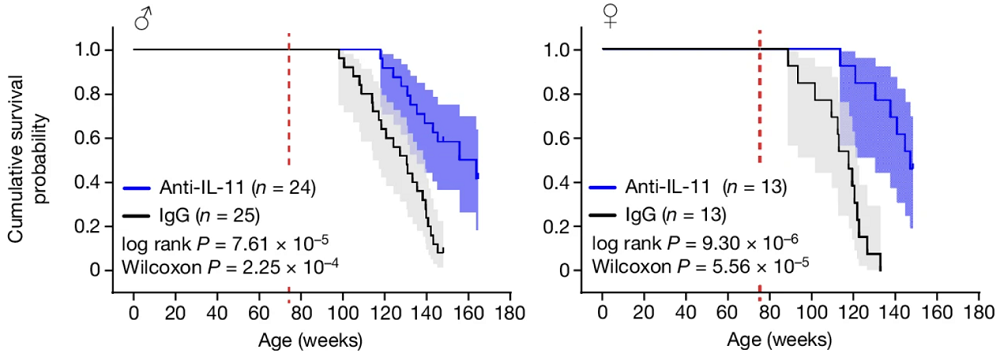A new mouse study has found that both germline knockout and late-life inhibition of the pro-inflammatory cytokine IL-11 lead to comparable and powerful healthspan and lifespan extension [1].

Late-Life Treatment Increases Mouse Lifespan by 25%
#1
Posted 19 July 2024 - 03:21 PM
As part of inflammaging, the pro-inflammatory cytokines that act as messengers, transferring and amplifying inflammatory signals, generally increase with age.
Despite its links to cellular senescence, IL-11 is not the most well-known of these cytokines. However, this close relative of the better-researched IL-6 has been shown to stimulate important age-related metabolic pathways, which include the mechanistic target or rapamycin (mTOR) [2]. Using rapamycin and other means to Inhibit mTOR potently increases healthspan and lifespan in various animal models [3].
Its various effects have made this obscure cytokine the subject of a new study by an international team of scientists, which was published in Nature.
Multiple health benefits
First, the researchers confirmed IL-11’s age-related upregulation in mice. Old mice had more IL-11 across many cell types and tissues, most notably in liver cells (hepatocytes), fat cells (adipocytes), and muscle cells (myocytes) in skeletal muscle.
To study the effects of IL-11, the researchers created genetically modified mice with the IL-11-producing gene knocked out (IL-11-KO). Despite missing the protein, the modified animals showed improved metabolism and lower levels of the senescent markers p16 and p21.
Two-year-old IL-11-KO mice had lower body weights, decreased fat mass, and increased lean mass. They also had attenuated serum triglyceride and cholesterol levels compared to controls.
Two markers of liver damage, ALT and AST, increased with age in wild-type mice but not in the genetically modified ones. Digging deeper into the molecular mechanisms behind those health benefits, the researchers found that mTOR was significantly downregulated in the study group, while AMPK, a kinase that mitigates mTOR, was upregulated.
IL-11 knockout also slowed down telomere attrition and the loss of mitochondrial DNA, which is a marker of mitochondrial health. Interestingly, average body temperature was slightly higher in the study group, hinting at differences in metabolism.
While genetic manipulations to the germ line are a neat way to investigate a protein’s function, they are hardly translatable into actual therapies. The researchers created a more realistic setting by treating 75-week-old mice (about equivalent to 55-year-old humans) with IL-11-blocking antibodies.
Despite the late start, the treated mice of both sexes quickly lost fat. Their frailty scores, full-body strength, and glucose metabolism improved significantly. Like the IL-11-KO mice, they had better glucose control and liver function, and slightly increased body temperature. Levels of phosphorylated mTOR plummeted, and of AMPK, a kinase that downregulates mTOR, increased.
Late start, mighty life extension
Most importantly, IL-11-deficient mice also received a lifespan boost. Genetic deletion of IL-11 increased median lifespan of both sexes by almost 25%, while late-life IL-11 inhibition increased median lifespan in males by 22.5% and in females by 25%.

These results are impressive and on par with some of the best life-extending interventions in mice currently known to science. The fact that the late-life treatment was practically as impactful as lifelong genetic deletion is particularly stunning. Importantly, while many known geroprotectors increase lifespan mostly or solely in one sex, the difference was minuscule here.
However, mice are not like humans in terms of causes of death. Lab mice usually die from cancer. The researchers report a much lower incidence of cancer in treated mice, but this is unlikely to be the leading cause of the life extension since IL-11 inhibition also produced a wide array of lifelong health improvements.
Inhibition of IL-11 increased lifespan in both male and female mice. The magnitude of lifespan extension remains to be fully determined but current data suggest that anti-IL-11 therapy given in late life increases median lifespan by more than 20% in both sexes. In these experiments, anti-IL-11 was injected in mice from 75 weeks of age (human equivalent to approximately 55 years of age) and it remains to be seen whether administration to older mice has similar effects and/or if short term anti-IL-11 therapy is effective for lifespan extension, as seen for rapamycin.
Literature
[1] Widjaja, A.A., Lim, WW., Viswanathan, S. et al. (2024). Inhibition of IL-11 signalling extends mammalian healthspan and lifespan. Nature.
[2] Widjaja, A. A., Viswanathan, S., Ting, J. G. W., Tan, J., Shekeran, S. G., Carling, D., … & Cook, S. A. (2022). IL11 stimulates ERK/P90RSK to inhibit LKB1/AMPK and activate mTOR initiating a mesenchymal program in stromal, epithelial, and cancer cells. IScience, 25(8).
[3] Harrison, D. E., Strong, R., Sharp, Z. D., Nelson, J. F., Astle, C. M., Flurkey, K., … & Miller, R. A. (2009). Rapamycin fed late in life extends lifespan in genetically heterogeneous mice. nature, 460(7253), 392-395.
View the article at lifespan.io










































